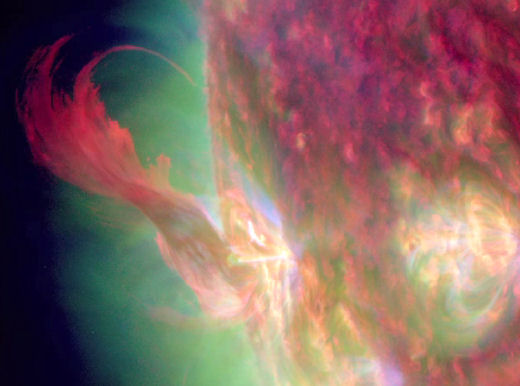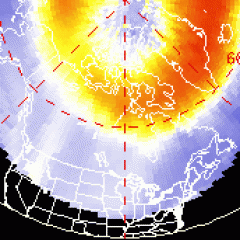~Space Weather Update~ Crackling with C Class Flares Continue [1]
CME TARGETS MERCURY, STEREO-A: A dense coronal mass ejection (CME) that left the sun during the late hours of May 26th will deliver a glancing blow to Mercury later today and a direct hit to NASA's STEREO-A spacecraft on May 28th. Earth is not in the line of fire. [CME forecast track [2]]
LIMB SHOTS: The sun's southeastern limb is hopping with activity. New sunspot AR1492, which just rotated onto the Earthside of the sun, is crackling with C-class [3] solar flares and hurling plumes of plasma off the stellar surface. Click on the image to set the scene in motion:
NASA's Solar Dynamics Observatory recorded the movie [4] during the late hours of May 25th. According to the 3D Sun app [5], another active region is approaching just behind this one and could boost solar activity even more when it emerges in the days ahead. Stay tuned.
more images: from Cai-Uso Wohler [6] of Bispingen, Germany

![]()
Solar wind
speed: 359.7 km/sec
density: 4.1 protons/cm3
explanation [7] | more data [8]
Updated: Today at 1705 UT
![]()
X-ray Solar Flares
6-hr max: B4 1101 UT May27
24-hr: C3 0552 UT May27
explanation [9] | more data [10]
Updated: Today at: 1700 UT
![]()
![]()
![]()
Daily Sun: 26 May 12
![]()
![]()
New sunspot 1492 is crackling with C-class [3] solar flares. Credit: SDO/HMI
![]()
![]()
![]()
Sunspot number: 70
What is the sunspot number? [12]
Updated 25 May 2012
Spotless Days
Current Stretch: 0 days
2012 total: 0 days (0%)
2011 total: 2 days (<1%)
2010 total: 51 days (14%)
2009 total: 260 days (71%)
Since 2004: 821 days
Typical Solar Min: 486 days
Updated 25 May 2012
The Radio Sun
10.7 cm flux: 117 sfu
explanation [13] | more data [14]
Updated 25 May 2012
![]()
![]()
![]()
Current Auroral Oval:
![]()
Switch to: Europe, USA, New Zealand, Antarctica
Credit: NOAA/POES
![]()
![]()
![]()
Planetary K-index
Now: Kp= 1 quiet
24-hr max: Kp= 2 quiet
explanation [16] | more data [17]
![]()
Interplanetary Mag. Field
Btotal: 3.4 nT
Bz: 1.6 nT south
explanation [18] | more data [19]
Updated: Today at 1706 UT
![]()
![]()
![]()
Coronal Holes: 26 May 12
![]()
![]()
There are no large coronal holes on the Earthside of the sun. Credit: SDO/AIA.



